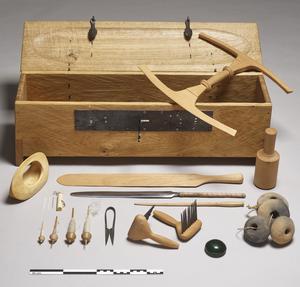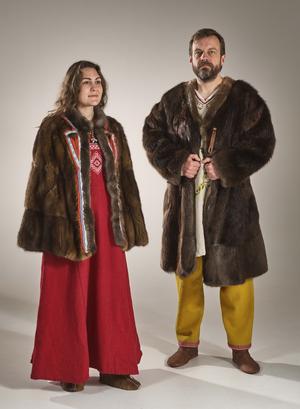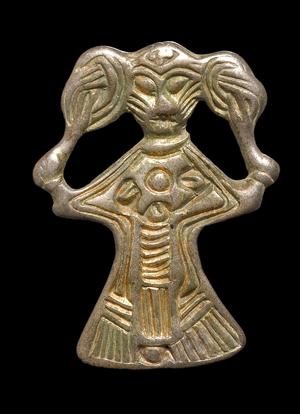Fashioning the Viking Age project 2018-2023

Part 1: Viking Age Textile Production
The aim of the first part of the project was to make Viking Age textile production visible and tactile. This part took its starting point in analyses of known archaeological finds of textile tools, textiles, skins and fibres from graves and settlements. By using controlled fibre sorting, spinning and weaving experiments we recreated a selection of textile samples that convey tactile and visual aspects of the Viking Age cloth culture. The samples werw based on textile finds from Hedeby Habour in Northern Germany. This locality was selected because it represents a different selection of textiles and production techniques than seen in contemporary grave finds. Likewise, it is important that a large part of the Hedeby textiles have been identified as parts of known garment types that were made for everyday use.
The outcome of Part 1 was a wooden chest, the so-called “Textile & Tool Box” that contains textile samples as well as reconstructed textile tools and fibre samples. The chest is based on the chest from Mästermyr, Gotland in Sweden and will be used for exhibition, outreach and teaching purposes at universities and museums.

Part 2: Viking Age Male and Female Clothing
The aim of the second part of the project was to reconstruct a male and a female outfit, based on the content in two Danish inhumation graves. The selected male grave from Bjerringhøj (also known as Mammen) is dated to AD 970-971, while the female grave from Hvilehøj is dated to the late 900s. The graves are located near Viborg and Randers respectively, in Denmark. In spite of the fact, that the textiles from both graves are very fragmented, they are nevertheless much larger than what is in average preserved in Viking Age graves in Denmark.
The outcome of Part 2 was two high-status outfits that are currently on exhibition in the Viking Age exhibition at the National Museum of Denmark. Read more about the outfits in the exhibition here.

Part 3: Viking Age Clothing and Textile Catalogue
The aim of the third part of the project is to create an overview of the many different sources linked to Viking Age clothing design. The archaeological sources consist of preserved skin and textiles, but also jewelry and other accessorizes. Iconographic sources, such as gold foil figures, pendants and tapestries contribute with knowledge about visual appearance and combinations of clothing items. Other important sources are contemporary and later written sources, such as the Icelandic Sagas, travel descriptions and chronicles. As many sources as possible are gathered in order to show the variation of Viking Age life and avoid garment stereotypes.
The outcome of Part 3 is an online open-access clothing catalogue, intended as a new platform and base for future interpretations and reconstructions of Viking Age clothing expressing different societal and status segments.
Available publications
Download the results from Project Part 1, "Fibres, Tools and Textiles" here as PDF or order a printed copy.
Download the results from Project Part 2, "From Analysis to Reconstruction" here as PDF or order a printed copy.
Download the results from our wool fibres analyses, "Viking Age Wool Fibres" here as PDF or order a printed copy.
Download our article "Velovervejede rekonstruktioner af de velklædte vikinger" (Arkæologisk Forum 51, 2024) here as PDF.
Final report
Read the final project report here
Presentation by Ulla Mannering at The Royal Danish Academy of Science and Letters (Danish only)
See the presentation here
